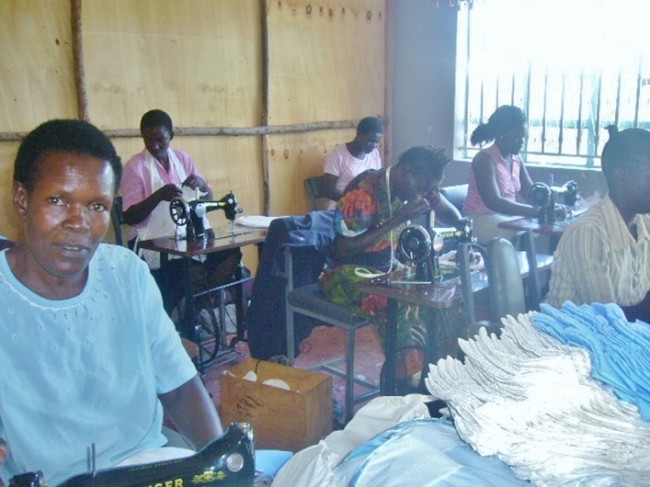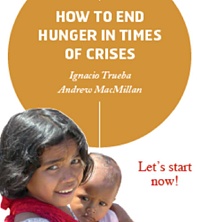Dear Friends of Got Matar,
On behalf of the Got Matar Community Development Group (GMCDG) I wish to thank you for your help and encouragement. These thanks come in the form of a report on what the Group has achieved this year and what it plans for the future to achieve its aim of expanding educational opportunities for young people in a rural society that has been robbed of a generation of bread-winners by HIV/AIDS.
In general, progress continues to be very encouraging and I hope that you will agree that good use is being made of your support. The secondary school is now well established, offering a chance for lots of children from poor families to get a better education. Each year the school is climbing up the District league table for Kenya Certificate of Secondary Education results. A rising number of graduates is going on to higher education.
The main focus of the Community is now on building up the practical skills training programme, run by the Got Matar Institute of Technology (IoT). This is hugely important for young people because the high levels of mortality caused by AIDS have interrupted normal parent-to-child transfer of knowledge. It is also enabling them to find good jobs or to set themselves up in business.
As I shall explain below, new arrangements are being put in place for managing donations in the UK, to take effect from 1February 2014 after our agreement with PEAS ends.
Secondary Education
Just over 7 years have passed since, at the request of the GMCDG, I invited friends and relations to help to pay for the building, equipping and furnishing of the 600-place secondary school that the Community wanted for their children. Thanks to the combination of the Group’s competence and zeal and of your money, all core facilities were constructed between 2006 and 2010. Since then, the Kenyan government has funded the construction of teachers’ houses and a large science laboratory as well as the installation of a mains electricity supply.
The most urgent task now is to construct a dormitory for girls. Building of the first phase, with assistance from the Australian NGO, Bricks and Cartwheels (B+C), should have started this year but has been delayed for various reasons, mainly internal to B+C. I have been assured by Harriet Stone of B+C that works will begin very soon.
The first pupils “graduated” from the secondary school in November 2010 and now the fourth batch of students has been taking final exams. By the end of this year over 300 pupils will have completed their studies. Many of them have gone on to university, teachers’ training colleges, nursing colleges and technical institutes. Others have stayed at home, reversing a brain drain that has in the past robbed the area of its best educated young people.
Since 2010, the main call on donor funds has been for paying bursaries for students, especially orphans from poor families who, while well qualified, would be unable to pay for school attendance. At present, there are 240 bursary holders who each receive the equivalent of Euro 150 (£125 or US$200) per year to cover tuition and examination fees, school lunches and uniforms plus shoes.
Some bursaries have been sponsored by individuals. The reporting demands on the school and the community, however, are considerable and hence we have decided not to accept any further such direct sponsorships. Those bursaries which have been prepaid for 4 years will continue until the pupils graduate, but in future the full costs of the bursary programme will be met from general income and will have the first call on donor funds.
The current annual cost of the bursary programme is about Euro 36,000 (£30,000, US$48,000). We hope to gradually reduce this by eventually cutting the number of new bursaries to about 40 per year (i.e. a total of 160 bursary holders out of the school’s 600 pupils). To reduce external dependence, the Community wants to create income-generating enterprises to meet a growing share of the bursary costs. This process started in 2013, with an investment in brick-making which should begin to generate income in 2014. If successful, we shall consider providing start-up capital for other similar initiatives.
This year former bursary holders have formed themselves into the Got Matar Bursary Old Students Association with the aim of raising funds for additional bursaries, mentoring students and educating them about AIDS and its prevention.
Practical Skills Training
The need to offer practical skills training was recognised in 2006, but for several years all the funds that we could raise had to go into building the Secondary School. Over the past 3 years, however, we have been able to support a progressively broadening training programme with courses in sewing/tailoring, cooking/catering, woodwork/furniture making, welding/blacksmithing, masonry and computer use. Some ladies have also trained themselves in weaving attractive plastic shopping baskets as a source of income. Most courses are run in rented buildings. The results have been encouraging and justify the Community’s decision to begin constructing permanent facilities.
One exciting development this year has been the creation of a link between the cooking course and Utalii College in Nairobi, the top hotel and tourism training institution in East Africa. Thanks to the generosity of one of our donors, the IoT has upgraded its cooking equipment in line with Utalii College staff advice, and will benefit from their guidance on curriculum design and training methods. Maybe one day the IoT will produce a celebrity chef!
It would be great if other donors who have a special interest in any of the training subjects could come forward and take a personal interest in working with IoT management with the aim of enhancing the quality of training, including through the supply of additional equipment.
The Ministry of Education has registered the IoT to run these courses. The aim is to arrive at 10 courses with a total enrolment of 200 students. The IoT will be financially self-sustaining, drawing its income from tuition fees and sales of goods and services. Pupils will be able to offset part of their fees by working on construction projects, including the girls’ dormitory and the permanent IoT facilities, and, at the same time, gain practical experience in applying their skills.
This year, IoT students have completed the preparation of the Institute’s site next to the secondary school, including land clearing, walling and latrine construction. The first phase of construction and equipment of purpose-built workshops will cost a further Euro 260,000 (£220,000, US$350,000) and, if we can raise the necessary funds, could be completed in two years. A project for this has been prepared (see www.gotmatar.org).
Water Supply
To date, Got Matar primary and secondary schools as well as the nearby clinic have relied on roof-top rainwater collection and storage tanks to meet their water needs. With the growing number of people now attending training or living on “the bare hill-top”, the provision of a mains water supply has become urgent. This will require a pump and 3 km of buried piping. The Group is looking into costs and into the possibility of covering part of these locally, but partial donor funding is still likely to be needed.
Changes in Donation Arrangements
John Rendel, CEO of PEAS (Promotion of Equality in African Schools), joined me in Got Matar in September 2006 to discuss plans for construction of the secondary school with Grace Ochieng Andiki, other members of the local community and government staff. He kindly agreed that PEAS (www.peas.org.uk) would serve as the UK-based registered charity for receiving and managing donations to GMCDG at least until the secondary school was fully operational. Earlier this year he said that he felt that PEAS had fulfilled its commitment and asked me to set up alternative arrangements by 31st January 2014.
John has been a great inspiration and source of practical help for us. While GMCDG has created just one secondary school, PEAS has built and is running 21 schools in Uganda and one in Zambia! PEAS was declared the winning International Development Charity of the Year in UK in 2013.
I and the GMCDG wish to express our sincere thanks to John and PEAS staff for their help over the past 7 years and to congratulate them for their great work.
We are very lucky to have begun to get to know ACE Africa (http://www.ace-africa.org/). ACE was founded 10 years ago for very much the same reasons as the GMCDG – to help rural communities, and especially children, in Kenya to cope with the huge problems posed by the AIDS epidemic. ACE enables children to become community health educators through engaging them in Child-to-Child Clubs. ACE staff focus on building capacity within communities to improve members’ health and well-being, including assisting orphans to attend school. They offer training in nutrition and food production, and they support the creation, especially by groups, of income generating activities.
As in the case of GMCDG’s programmes, ACE Africa’s Kenyan programme is implemented entirely by nationals and responds to locally identified needs and opportunities.
ACE has been active in the neighbouring District of Siaya and, with support from GMCDG, has in recent months begun operations in Bondo District around the Got Matar area. Augustine Imbuye Wasonga, one of ACE’s 3 Founders and its Kenya Country Director has written to me saying “We look forward to working with Got Matar. They will learn from us and we will also be able to learn from them, and promote the training opportunities that they have in practical skills”. GMCDG and ACE have agreed to engage in joint planning in the coming months, including arrangements for ACE Africa (UK) to manage UK donations for GMCDG with the aim of having a new system in place by 1st Feb 2014. I shall inform you of the details which will also be posted on the Got Matar website (www.gotmatar.org).
We are very grateful to Vanda Altarelli for her diligence in handling Euro-denominated donations to Got Matar through Associazione SONIA (www.associazionesonia.org). This arrangement will continue to operate for the foreseeable future.
If any readers have any questions, comments or suggestions, please get in touch with either me or Grace Ochieng Andiki ([email protected]).
With best wishes,
Andrew MacMillan

In addition to learning how to design and make clothes, Institute of Technology sewing class students are applying their skills to produce goods for the community, such as school uniforms as well as curtains for the Women’s Centre. In this picture, a student is making low-cost sanitary towels for use by girls attending schools in the area. This raises income for the IoT, cuts costs of living for pupils and improves school attendance. The chairs and desks used by the sewing class were designed and made by IoT metalwork and woodwork students who have also built bunks for the girls’ dormitory.
